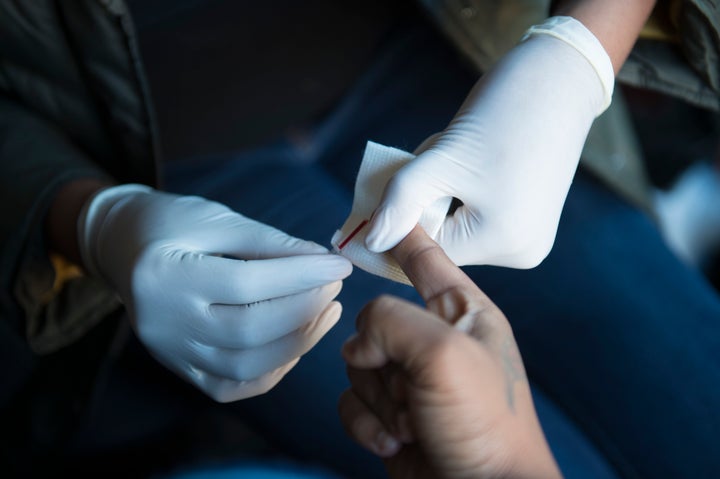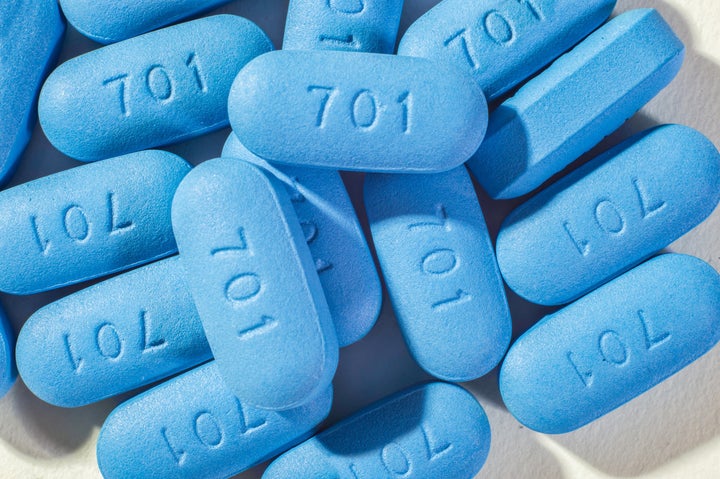
Nationally, the United States is experiencing a continued overall decline in the number of new HIV diagnoses. But in some major cities, women’s HIV rates have not been declining as quickly as men’s in recent years.
Although men who have sex with other men are still most susceptible to HIV in the U.S., women nonetheless made up 19 percent of new diagnoses in 2016. Black women specifically are disproportionately affected by HIV, accounting for 61 percent of women living with the disease and 19 percent of new diagnoses, while making up only about 7 percent of the population.
Despite all this, public health and education efforts to reduce new HIV diagnoses have not typically targeted women.
“Our epidemic historically, and still contemporarily, has mostly been defined as one focused on gay men because they experience the highest burden of HIV and always have,” said Dr. Judith Auerbach, HIV specialist and professor of medicine at the University of California, San Francisco. “But that doesn’t mean you don’t look at women.”
In recent years, major cities like Washington D.C. and New York City have reported increases in new HIV diagnoses among women ― with rates fluctuating year over year.
In New York City, though new HIV diagnoses among cisgender and transgender women decreased 11. 2 percent between 2014 and 2016, diagnoses among their male counterparts decreased nearly twice as fast (19.6 percent) during that time. In Washington D.C., HIV rates among cisgender women increased 11.7 percent while rates among cisgender men decreased 27.4 percent. The District of Columbia Department of Health partially attributed this increase in women to an improvement in screening among women ages 50-59. (Transgender individuals are generally at higher risk of contracting HIV than cisgender people.)
But Michael Kharfen, senior deputy director of the department’s HIV/AIDS, Hepatitis, STD, and TB Administration, said that the overall lack of consistent decline in HIV diagnoses among women in recent years indicated that more had to be done around prevention for women in the nation’s capital.
“[We have been] focused on gay men because they experience the highest burden of HIV and always have. But that doesn’t mean you don’t look at women.””
- Dr. Judith Auerbach, HIV specialist
As cities and organizations aim to raise awareness about HIV transmission in women, they are emphasizing the public health benefits of pre-exposure prophylaxis (PrEP). The once-daily oral pill, which combines two HIV medicines, can reduce a person’s risk of contracting HIV from sex by more than 90 percent and has been successfully embraced by many in the LGBTQ community.
While HIV transmission via injection drug use also plays a part in how HIV impacts women ― making up 12 percent of new diagnoses nationally ― the 87 percent of women who contracted the disease through sexual contact in 2016 shows just how impactful the drug could be on the population.
CDC researchers view the pill, which the FDA approved in 2012, as having contributed to the decline in the number of new HIV diagnoses across the country and public health officials hope it will have the same effect on women. Washington D.C. and New York City are just two cities that have ramped up public health campaign ads and educational efforts in hopes of bringing more women into the PrEP conversation.
A Lack Of Awareness
Currently, women are far less likely to take PrEP. A recent analysis by the CDC found that out of the 258,080 heterosexually active adults who could potentially benefit from the pill, 68 percent (176,670) were women.
Separate data from researchers at Emory University found that out of 61,298 active PrEP prescriptions, men were 10 times more likely to be on PrEP than women. To calculate the uptake of PrEP prescriptions based on need, researchers developed a complex metric called a “PrEP-to-need ratio” that looks at the ratio of prescriptions per new HIV diagnoses. This concluded that men were four times more likely than women to have a PrEP prescription when needed. In raw numbers, only 2,695 women in the U.S. had active PrEP prescriptions in 2017, compared to 58,637 men.
Women’s lack of awareness about PrEP has been an ongoing problem since the drug was first approved nearly six years ago, in part due to early confusion regarding PrEP’s effectiveness for women.

Two early studies ― one conducted in Kenya, South Africa and Tanzania in 2012; the other in South Africa, Uganda and Zimbabwe in 2015 ― sent a wave of misinformation through the infectious disease community after results seemed to show PrEP was ineffective for women. Researchers later discovered the problem was actually that women in the study weren’t properly taking the medication, due to a number of factors, including medical mistrust and concerns over side effects.
“The word on the street was: PrEP doesn’t work for women, women don’t want PrEP,” Dr. Auerbach said.
Despite that initial negative impression, the current consensus about PrEP’s efficacy is clear: It is as safe and effective for women as it is for men ― though it takes a bit longer for women who have vaginal sex to get the protective effect compared to people who exclusively have anal sex. It’s also been found to be safe for women who are pregnant or breastfeeding.
Despite PrEP’s effectiveness, changing the way medical providers screen for the pill is crucial to increasing PrEP use among women, according to Shannon Weber, director of the women’s health organization, HIVE. Unless a patient asks about PrEP, providers generally only offer the pill to women who they perceive to be at high risk based on brief conversations. This strategy isn’t currently serving women, Weber said.
“Instead of screening women to see if they should be offered PrEP, all women should be educated about PrEP and [then] women themselves can opt in,” she said.
Another barrier to women taking the pill is that women may not understand they’re even at risk of HIV, said Dr. Kenneth Mayer, a principal investigator in one of the first studies to show PrEP’s overall effectiveness and a professor of medicine at Harvard University. This is particularly true for sexual transmission, in which a woman must first know her partner’s risk to understand her own.
“If the woman is monogamous and she’s unaware that her partner is at higher risk, then it’s very hard for her to know that she has to protect herself,” he said.
Various social stigmas also remain a big challenge when it comes to PrEP, according to Dr. Auerbach. For one, some health care providers carry judgment toward women who use the pill.
“It’s like contraception was [viewed] back in the 60s and 70s,” she said. “It’s the notion that, ‘Oh, this is about you being able to have sex outside your primary marriage or relationship.’”
A fear of being viewed as promiscuous or lingering social attitudes about HIV are also major barriers associated with taking PrEP, according to Dr. Oni Blackstock, assistant commissioner for the New York City health department’s Bureau of HIV/AIDS Prevention and Control.
“There’s also HIV stigma if you do have a partner who is known to be HIV positive, the thinking could be: ‘Why would you have sex with an HIV positive person?’” she said.
A Desire To Learn


Despite these challenges, many women are open to using PrEP. A 2015 national study led by Dr. Auerbach found that women were generally open to taking the pill as long it was safe, effective and affordable.
“They were really interested in using it and they were pissed off they hadn’t heard about it,” she said. A subsequent 2017 study in New York City’s Bronx borough had similar findings, specifically among black women and Latinas.
And proper dissemination of information can certainly lead to an uptake in PrEP usage.
As soon as Fleur de Kine, 39, heard about PrEP in 2016, the straight and single fitness instructor felt she could benefit from the pill. But she initially put off asking her provider about it.
“I wanted to get on it but there was always that stalling: ‘I don’t want to have to go to the doctor, I’ll talk to the doctor next time I see them’,” said de Kine, who lives in New York City. “Then my friend contracted HIV.”
De Kine, who has been on PrEP for a year and a half now, said she now tries to educate those around her about the pill.
“I bring it up with my friends,” she said. “A lot of times people don’t even know about it and if they do know about it, it goes back to, ‘Oh, I’m not really risky or I’m not really in that risk group.’ And it’s kind of like: ‘OK, well you just told me your guy is cheating on you.’”
But de Kine’s outspokenness about PrEP is unusual, according to Dr. Blackstock. Many women who take PrEP keep their status to themselves for fear of being stigmatized. This, in turn, prevents crucial word-of-mouth promotion that could help normalize PrEP use.
Changing PrEP Outreach
This lack of awareness around PrEP is a major problem in cities who’ve seen an increase in HIV rates among women. The New York City Department of Health and Mental Hygiene revealed its “Living Sure” public ads in March, and a city official told HuffPost they were partly inspired by Washington D.C.’s 2016 “PrEPForHer” campaign.
Both campaigns place special focus on women of color, who are disproportionately impacted by HIV in both cities, and if they prove successful the model could ultimately be used by other metropolitan areas grappling with increasing HIV rates among women.
“When we look at women who are newly diagnosed with HIV, whether they are cis women or trans women, greater than 90 percent are black and Latina,” said Dr. Blackstock about new diagnoses in New York City. “That disparity is very clear to us.”
For Dr. Blackstock, raising awareness around PrEP among women is not only crucial in the ongoing fight against HIV but in protecting one of the most vulnerable populations in society.
“It has been largely underutilized by women,” Dr. Blackstock said, emphasizing that the pill is unique because it’s the only user-controlled method women can use to prevent HIV when they’re unable to negotiate safe sex with a partner.
“If there is an additional tool we can provide women that can empower them and help them protect themselves against HIV, then I’m very excited to promote that,” she added.
